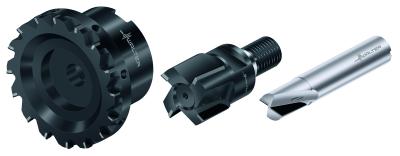
Walter has introduced the MP060, MP160 and MP260 face, shoulder and slot drill milling cutters with brazed PCD cutting edges, a new suite of products for machining aluminum, Al-Si alloys, magnesium and magnesium alloys, as well as composites and plastics. These new milling cutters offer significant benefits, primarily with respect to their service life, surface quality and efficiency.
The MP060 face milling cutter with a great number of teeth (z) between 10 and 22, and with diameters from 40 mm, can be used for roughing and finishing large surfaces and flat shoulders. The MP160 (z = 3–4) and MP260 (z = 2–3) shoulder and slot milling cutters, with either cylindrical shank or ScrewFit adaption and diameters of 16–40 mm and 4–20 mm respectively, are suitable for smaller flat surfaces, for plunging (MP260) and full slotting, as well as, in the case of the MP160, ramping, drilling and re-drilling work. All three milling cutters are equipped with internal coolant supply and can be used with emulsions and minimum quantity lubrication.
The service life of these new milling cutters, which is significantly longer than that of solid carbide tools, is primarily the result of the wear-resistant WDN20 Walter grade, as well as reduced cutting forces and low-vibration microgeometry. Their precise machining, combined with the internal coolant supply, enables users to produce high-quality surface finishes. In addition, relatively low cutting material costs, fewer tool changes due to the longer service life, and the fact that the milling cutters can be reconditioned (diameters of 6 mm or more) also increase the tools' service life. These new Walter milling cutters are particularly well suited for the automotive, electronics and general metalworking industries.
Contact Details
Related Glossary Terms
- alloys
alloys
Substances having metallic properties and being composed of two or more chemical elements of which at least one is a metal.
- composites
composites
Materials composed of different elements, with one element normally embedded in another, held together by a compatible binder.
- coolant
coolant
Fluid that reduces temperature buildup at the tool/workpiece interface during machining. Normally takes the form of a liquid such as soluble or chemical mixtures (semisynthetic, synthetic) but can be pressurized air or other gas. Because of water’s ability to absorb great quantities of heat, it is widely used as a coolant and vehicle for various cutting compounds, with the water-to-compound ratio varying with the machining task. See cutting fluid; semisynthetic cutting fluid; soluble-oil cutting fluid; synthetic cutting fluid.
- flat ( screw flat)
flat ( screw flat)
Flat surface machined into the shank of a cutting tool for enhanced holding of the tool.
- gang cutting ( milling)
gang cutting ( milling)
Machining with several cutters mounted on a single arbor, generally for simultaneous cutting.
- metalworking
metalworking
Any manufacturing process in which metal is processed or machined such that the workpiece is given a new shape. Broadly defined, the term includes processes such as design and layout, heat-treating, material handling and inspection.
- milling
milling
Machining operation in which metal or other material is removed by applying power to a rotating cutter. In vertical milling, the cutting tool is mounted vertically on the spindle. In horizontal milling, the cutting tool is mounted horizontally, either directly on the spindle or on an arbor. Horizontal milling is further broken down into conventional milling, where the cutter rotates opposite the direction of feed, or “up” into the workpiece; and climb milling, where the cutter rotates in the direction of feed, or “down” into the workpiece. Milling operations include plane or surface milling, endmilling, facemilling, angle milling, form milling and profiling.
- milling cutter
milling cutter
Loosely, any milling tool. Horizontal cutters take the form of plain milling cutters, plain spiral-tooth cutters, helical cutters, side-milling cutters, staggered-tooth side-milling cutters, facemilling cutters, angular cutters, double-angle cutters, convex and concave form-milling cutters, straddle-sprocket cutters, spur-gear cutters, corner-rounding cutters and slitting saws. Vertical cutters use shank-mounted cutting tools, including endmills, T-slot cutters, Woodruff keyseat cutters and dovetail cutters; these may also be used on horizontal mills. See milling.
- polycrystalline diamond ( PCD)
polycrystalline diamond ( PCD)
Cutting tool material consisting of natural or synthetic diamond crystals bonded together under high pressure at elevated temperatures. PCD is available as a tip brazed to a carbide insert carrier. Used for machining nonferrous alloys and nonmetallic materials at high cutting speeds.
- shank
shank
Main body of a tool; the portion of a drill or similar end-held tool that fits into a collet, chuck or similar mounting device.
- slotting
slotting
Machining, normally milling, that creates slots, grooves and similar recesses in workpieces, including T-slots and dovetails.

